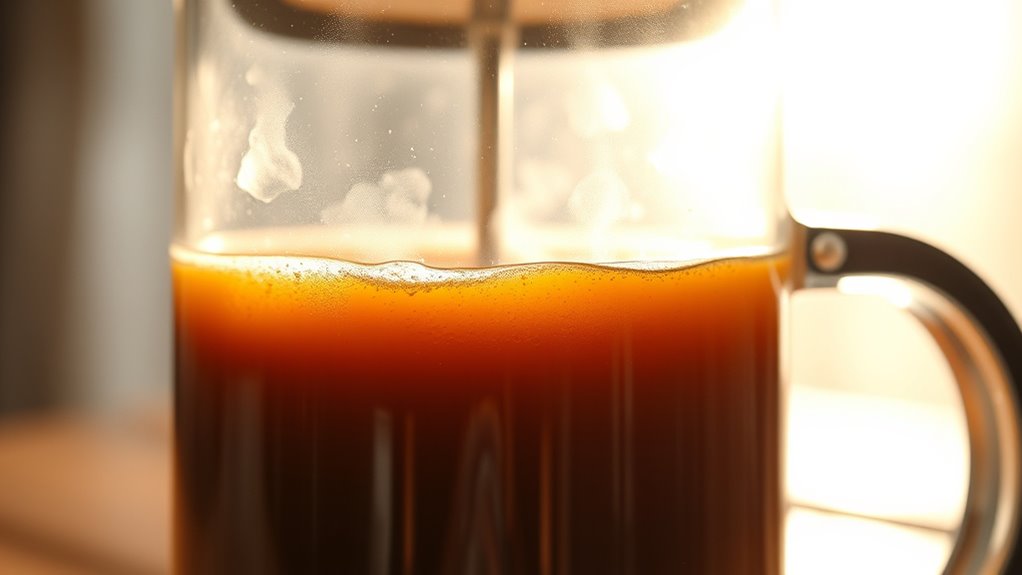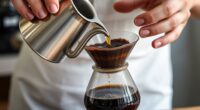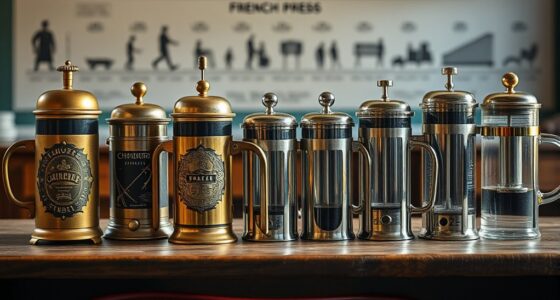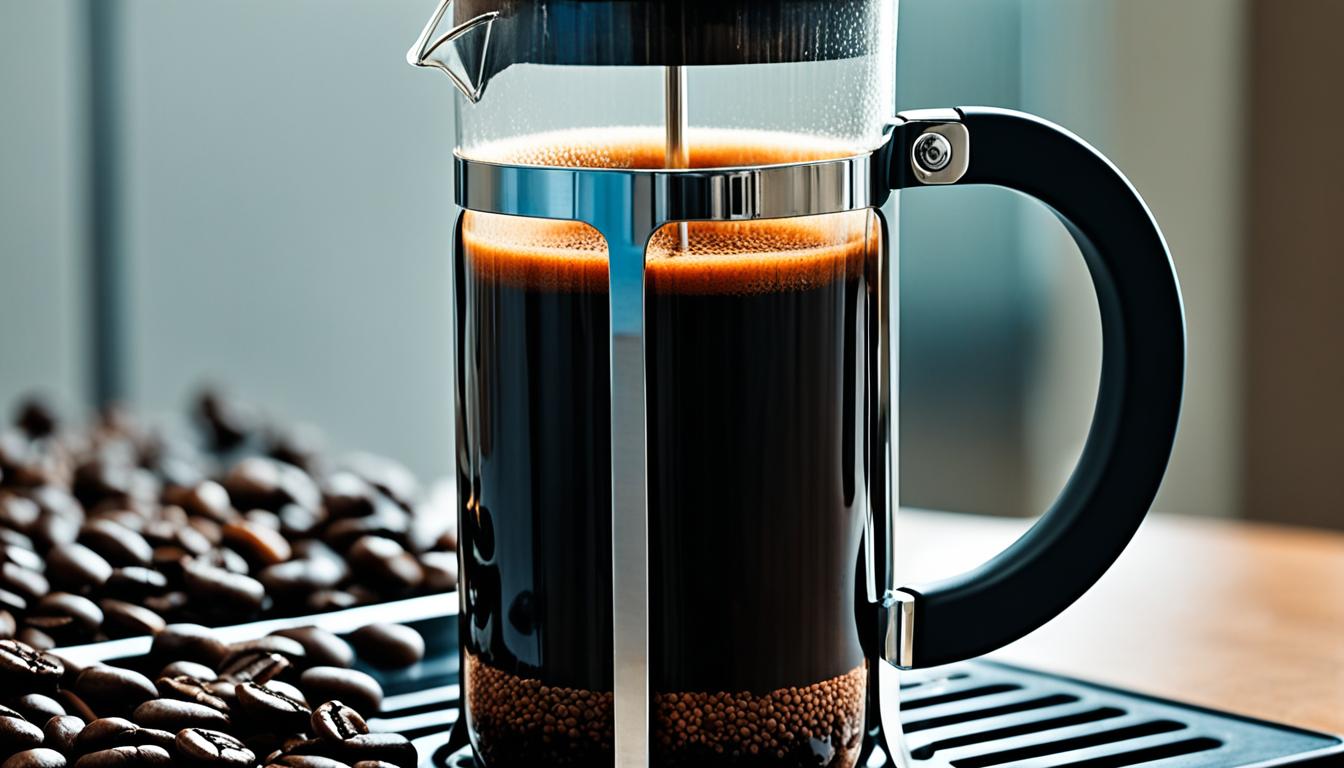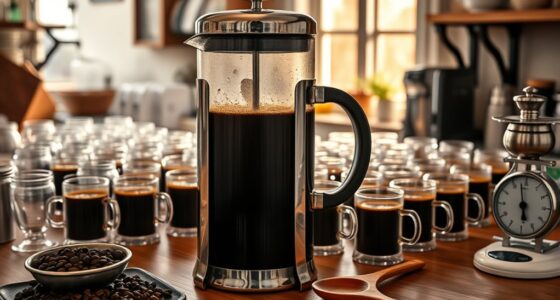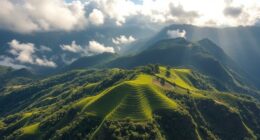For perfect French press coffee, you’ll want your water to be just off the boil, between 195°F and 205°F. This temperature range helps extract full flavors without over-extracting and causing bitterness. Bringing water to a boil and then letting it sit for a few seconds usually gets you there. Maintaining a consistent temperature during steeping is key to a balanced brew. Keep going to discover more tips on mastering your French press technique.
Key Takeaways
- “Hot” water for French press should be between 195°F and 205°F (90°C to 96°C).
- Bring water to a boil, then let it sit for 30 seconds to reach the ideal temperature.
- Use a thermometer for precise temperature control during brewing.
- Preheat the French press with hot water to maintain consistent temperature.
- Avoid boiling water directly on grounds to prevent over-extraction and bitterness.

Achieving the perfect cup of French press coffee starts with paying attention to water temperature. When it comes to coffee brewing, temperature control is essential because it directly influences how well your beans release their flavors. If the water isn’t hot enough, your coffee can taste weak, flat, or under-extracted. Conversely, if it’s too hot, you risk over-extraction, resulting in bitter, harsh flavors. To get things just right, you need to understand what temperature range is ideal for French press brewing and how to maintain it.
Typically, the optimal water temperature for French press coffee falls between 195°F and 205°F (90°C to 96°C). This range allows the coffee grounds to steep properly, extracting the full spectrum of flavors without pulling out undesirable bitter compounds. To achieve this, you can bring your water to a boil and then let it sit for about 30 seconds before pouring over the grounds. This simple step helps bring the temperature down to the right level. Some coffee enthusiasts prefer using a thermometer to be precise, especially if you’re experimenting with different beans or roast levels.
Controlling the temperature during coffee brewing isn’t just about initial heating; it’s also about maintaining a consistent heat throughout the steeping process. When you pour hot water over the coffee grounds, it’s important to do so evenly to ensure all the grounds are saturated. Then, placing the lid on your French press helps retain heat and maintain a stable temperature, which allows for proper extraction. If you notice the temperature dropping during steeping, you might want to preheat your French press with hot water beforehand, preventing heat loss and ensuring the water stays within the ideal temperature zone.
Another tip for precise coffee brewing is to contemplate the type of water you’re using. Using fresh, filtered water at the correct temperature provides a cleaner taste and better extraction, highlighting the importance of temperature control in the overall process. Remember, the goal is to keep the water just below boiling point, as boiling water can scorch the coffee grounds, creating undesirable flavors. Understanding temperature control is key for consistently great French press coffee.
Frequently Asked Questions
Can I Use Boiling Water Directly for French Press Brewing?
You can use boiling water for French press brewing, but it risks over-extracting the coffee and creating a bitter taste. Ideally, let the water cool for about 30 seconds after boiling to reach the best temperature of around 200°F (93°C). Water temperature safety matters, as too hot water can cause burns or damage your equipment. Adjusting the temperature ensures a smoother, more flavorful brew without risking safety or quality.
How Does Water Temperature Affect the Coffee’s Flavor Profile?
You’ll notice that water temperature plays a crucial role in water extraction, directly impacting your coffee’s flavor profile. When you use water that’s too hot, it can over-extract, leading to bitterness. Conversely, too cool water results in under-extraction, making your coffee taste weak. To enhance flavor, aim for a temperature around 195-205°F, ensuring ideal water extraction that brings out the rich, nuanced flavors in your French press brew.
Is There a Temperature Range Ideal for Different Coffee Roasts?
Think of your coffee as a painting; different roasts need different hues. For light roasts, aim for a temperature range of 195-205°F to highlight delicate flavors. Medium roasts thrive at 200-210°F, balancing brightness and body. Dark roasts prefer 200-220°F for richer extraction. Precise temperature control guarantees you capture each roast’s unique essence, allowing you to tailor your brew for ideal flavor and aroma with roast-specific extraction.
Should I Adjust Water Temperature Based on Coffee Grind Size?
You should adjust your water temperature based on your coffee grind size to optimize extraction. For finer grounds, lower brewing temperature helps prevent over-extraction, while coarser grounds may benefit from slightly hotter water for better flavor. Maintaining water temperature consistency is key, so make brewing temperature adjustments carefully to guarantee each cup has the right balance. Experimenting with small changes helps you find the perfect temperature for your grind size.
How Long Should I Let the Water Sit Before Pouring?
You should let the water sit for about 30 seconds after boiling before pouring. This pause allows for water aeration, which improves extraction and flavor. During this time, the temperature drops slightly, optimizing brew time and preventing over-extraction. By giving the water a moment to settle, you guarantee consistent contact with your coffee grounds, resulting in a balanced, flavorful French press brew.
Conclusion
So, next time you brew with your French press, know that the ideal water temperature hovers around 200°F. Some say boiling water ruins the flavor, but recent studies suggest slightly cooler water extracts more nuanced aromas. Don’t just guess—trust the science and experiment a bit. You might discover your perfect cup isn’t at the boiling point after all. After all, isn’t coffee about personal taste? Happy brewing!
